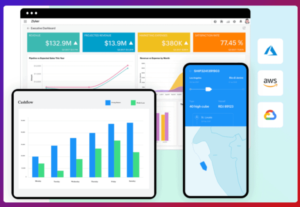BrainBlog for Zoho by Jason Bloomberg
 AI is in the process of transforming the analytics marketplace, just as it is disrupting the rest of the enterprise IT landscape.
AI is in the process of transforming the analytics marketplace, just as it is disrupting the rest of the enterprise IT landscape.
While touting the greater power and simplicity of their products, many analytics tools vendors are overpromising – hoping that their shiny new AI capabilities will make their complex analytics tools easier to swallow.
Zoho, in contrast, is taking a different approach. It has been building Zoho Analytics since 2009 – and since the beginning, the company has focused the product on users from companies of all sizes and industries.
Zoho has also built Analytics to be a self-service platform: easy to use for all types of business users, from executives to the knowledge workers that keep businesses humming.
Zoho has also been implementing AI for a number of years – not only in Zoho Analytics, but across its product line of business applications.
The company has strengthened the AI capabilities in version 6.0, the latest release of Zoho Analytics – while improving capabilities for enterprise users as well as individuals at small and midsize firms.
The two dimensions of Zoho Analytics
Zoho refers to its analytics product as ‘analytics for all,’ because it simultaneously serves all types of business users as well as enterprise power users.
Within the enterprise, the product serves various types of business analysts (BAs) as well as people with explicit data-centric roles, including data analysts, data engineers, data scientists, and others.
Some of these professionals use Zoho Analytics to build machine learning (ML) models on the platform for specific analytics workloads. Other individuals use the tools to ingest data, analyze the data, and set up data models.
To serve these two different constituencies, Zoho built Zoho Analytics to be extensible and simple to integrate with, while providing data preparation and data management capabilities as well as core analysis capabilities that lead to the creation of reports and dashboards.
Zoho analytics also supports the entire business intelligence (BI) workflow, forming an end-to-end, self-service BI platform. For enterprises, this combination of power and simplicity helps relieve the burden of complexity and cost that ‘enterprise-class’ analytics tools suffer from.
The power of composability
While Zoho Analytics is an end-to-end BI platform, it is also composable: it consists of different building blocks assembled into an integrated platform.
Each of these building blocks, for example, data preparation and data management, also serves as a stand-alone component.
Data preparation includes data cleansing, transformation, and enrichment. Some Zoho customers use this component as an independent service to ingest data from one system and then prepare, enrich, and transform the data before pushing it into another system.
Embedded BI is another composable component that enterprises can embed into their own applications to build analytics capabilities directly into those apps.
Adding AI to the mix
Now that generative AI (genAI) is all the rage, people in various roles and different size companies are looking for ways to leverage this technology to simplify their work.
Someone might ask, for example, whether AI can make tasks like data cleansing easier. It should be possible to prompt an AI assistant to fix all the quality issues in a database table, for example.
Zia, Zoho’s AI assistant, can handle such tasks, whether it be a user command or simply understanding what the user is trying to accomplish and then automating the necessary tasks.
Zoho Analytics’ AI can analyze an entire data set, look at the various trends in individual tables, charts, or reports, and then tell the user what they should be interested in – even details that might not be obvious upon reviewing a chart or dashboard.
Customers are impressed with Zoho Analytics’ expanded AI capabilities. “The Zia Insights [powered by Zoho Analytics] diagnostic analysis is a significant new capability that enabled us to dive into key drivers behind any sales impact,” said Manikandan Moorthi, IT Manager for Awal Dairy. “I’m sure it will help us stay on top of things, drive our sales, and customer satisfaction.”
Zoho brings genAI models directly into Zoho Analytics to simplify the adoption of the BI platform. On the flip side, the platform also enables users to build their own ML models via a pro-code, developer-friendly interface – giving developers (or other power users) the ability to extend the platform to meet an organization’s specific needs.
The Intellyx Take
Zoho Analytics and its individual components easily work on a stand-alone basis, but the true power of the platform is how well it works within the context of the landscape of business applications any organization is likely to have.
The platform works seamlessly with other Zoho business applications (as all Zoho’s products do), leveraging its massively scalable data warehousing engine and the rest of Zoho’s cloud platform.
Given Zoho’s deep understanding of business applications generally, furthermore, it’s no surprise that Zoho Analytics works with any application across the business landscape. For example, Zoho Analytics can connect seamlessly with, say, Salesforce and Zendesk, handling the integration plumbing automatically.
Zoho refers to this connectivity as ‘blending,’ as Zoho Analytics automatically combines the data from multiple sources without additional user input. Instead, users focus on the results they want from the platform – a report, graph, or chart, for example, highlighting the important information necessary to run the business.
In the final analysis, Zoho Analytics combines power and simplicity – the power of AI and enterprise-class capabilities with the simplicity that any user will find valuable, regardless of their role or the company they work for.
Copyright © Intellyx BV. Zoho is an Intellyx customer. None of the other organizations mentioned in this article is an Intellyx customer. Intellyx retains final editorial control of this article. No AI was used to write this article.



